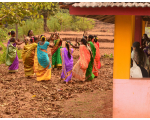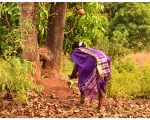In the early 1970s, women from Oshi village approached their sarpanch, Banu Gunaji Solim, with a unique complaint. Most men in the village had resorted to alcoholism and abuse towards their wives. Banu knew he had to engage the men productively. He decided to train them in performing arts and put together a team of actors and musicians, establishing the Shree Navalaidevi Naman Mandal. Thus began the khele performance tradition of Oshi village.
Khele is a folk tradition of the Kunbi community (land tillers) of the Konkan region of Maharashtra. An art form that keeps evolving with changing times, khele’s history can be traced back to folk performances influenced by Natya Shastra (a Sanskrit text on performing arts attributed to a sage named Bharata Muni). However, the genesis of khele is uncertain due to lack of written documentation on this art.
Khele is performed in winter and summer. The first performance of the year is sacred. Every year, after Diwali, the khele mandal (troupe) from every village performs their first khele of the year, which begins with a religious performance called thap, where the performers seek the blessings of the village goddess to avert misfortune. Similar to lavani (women-led folk performance popular across Maharashtra), khele artists from a village can be invited to perform in other villages or homes of other patrons. Hence, the first khele of the year is performed before the village and with the blessings of the gaondevi (village goddess).
This photoessay documents the thap at Oshi village in Ratnagiri district of Maharashtra. Khele has brought the community in Oshi together and steered the men away from alcohol. In order to celebrate this victory, the first khele is performed on Makar Sankranti, a woman-centric festival, where married women apply tilak of turmeric and kumkum to one another and wish for their husbands’ long lives. They exchange flowers, sweets (usually laddu made from jaggery and sesame seeds) and household gifts. Thus, the first khele in Oshi is a tribute to the women of the village; the day begins with them celebrating Makar Sankranti and the night is coloured by vivid performances by the men.
















